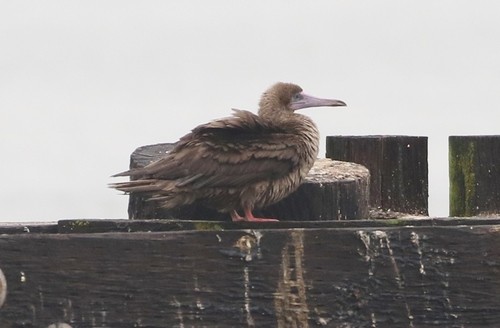Red-footed Booby
A species of Boobies Scientific name : Sula sula Genus : Boobies
Red-footed Booby, A species of Boobies
Botanical name: Sula sula
Genus: Boobies
Content
Description General Info
 Photo By silversea_starsong , used under CC-BY-NC-4.0 /Cropped and compressed from original
Photo By silversea_starsong , used under CC-BY-NC-4.0 /Cropped and compressed from original Description
The red-footed booby is the smallest member of the booby and gannet family at about 70 cm (28 in) in length and with a wingspan of up to 152 cm (60 in). The average weight of 490 adults from Christmas Island was 837 g (1.845 lb). It has red legs, and its bill and throat pouch are coloured pink and blue. This species has several morphs. In the white morph the plumage is mostly white (the head often tinged yellowish) and the flight feathers are black. The black-tailed white morph is similar, but with a black tail, and can easily be confused with the Nazca and masked boobies. The brown morph is overall brown. The white-tailed brown morph is similar, but has a white belly, rump, and tail. The white-headed and white-tailed brown morph has a mostly white body, tail and head, and brown wings and back. The morphs commonly breed together, but in most regions one or two morphs predominates; for example, at the Galápagos Islands, most belong to the brown morph, though the white morph also occurs. The sexes are similar, and juveniles are brownish with darker wings, and pale pinkish legs, while chicks are covered in dense white down. The species has been recorded three times from Sri Lanka. In September 2016, a male red-footed booby was found washed up on a beach in East Sussex, UK, 5,000 miles from its nearest usual habitat. It was the first of its species ever recorded in the UK. The bird, later named Norman, was said by some to be exhausted and malnourished, though it flew onto the beach freely and was of normal weight when checked. He was brought back to health before being transported by plane to an environmental center in the Cayman Islands in December 2016, where he subsequently died before ever being released into the wild. In January 2017, a red-footed booby was sighted on the New Zealand mainland for the first time. A red-footed booby was observed to be preyed upon by a large coconut crab on the Chagos Archipelago in 2016. 
Size
66-71 cm (26-28 in)
Life Expectancy
40 years
Nest Placement
Shrub
Clutch Size
1 egg
Feeding Habits
Red-footed Booby primarily feed on flying fish, squid, and small prey driven to the surface by tuna. They hunt by flying low over the sea and executing swift plunge-dives or by catching prey in mid-air. Agile hunters, red-footed Booby swallow their catch immediately and may opportunistically follow ships for fish.
Habitat
Red-footed Booby thrive in the warm, stable climates of tropical and subtropical marine environments, predominantly over open oceans. Their breeding habitats are remote coral atolls and volcanic islands in the pantropical zone, utilizing dense vegetation, often with shrubs or trees, for nesting. In nonbreeding periods, they inhabit extensive pelagic waters, influenced by changes in ocean currents such as during El Niño events.
Nest Behavior
Red-footed Booby builds nests in crowns of seaside trees or on the ground. Timing for nest building and egg-laying is not specified. Both parents share in nurturing the eggs and chicks, demonstrating a cooperative care system.
Nest Characteristics
Red-footed Booby typically nests in seaside trees like fig and mangrove, or on grass and cement blocks in treeless areas. Their nests, about 12 inches across and 4.5 inches tall, are constructed of twigs, often lined with grasses or leaves, with a 5.8 inches wide inner depression.
Dite type
Piscivorous
General Info
Feeding Habits
Bird food type
Behavior
Red-footed Booby display a complex social structure, engaging in elaborate aerial courting rituals and demonstrating strong pair bonds that can last for over a decade. They perform distinctive mating displays, such as sky-pointing and head-shaking, to attract mates. Social monogamy is prevalent among red-footed Booby, with partners often returning to previous nest sites, which they spaciously arrange within colonies. These birds maintain relationships with meticulous preening and consistent courtship displays, illustrating their intricate social behaviors.
Species Status
The International Union for the Conservation of Nature (IUCN) lists the red-footed booby as a species of least concern, though the population worldwide is decreasing. The warm phase (El Niño) of the El Niño–Southern Oscillation in 1982 and 1983 negatively impacted on breeding on Christmas Island as higher water temperatures reduced food supply. Where usually 6000 pairs nested, 30 pairs and the around 60 pairs attempted breeding in 1982 and 1983 respectively. 
Scientific Classification
Phylum
Chordates Class
Birds Order
Gannets and Relatives Family
Sulids Genus
Boobies Species
Red-footed Booby